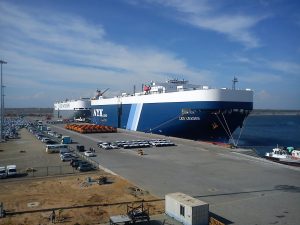By Shannon Tiezzi
 On Wednesday, the United States announced yet another tranche of sanctions targeting Chinese companies. This time, 24 Chinese firms were added to the Entity List, which prevents them from doing business with U.S. companies.
On Wednesday, the United States announced yet another tranche of sanctions targeting Chinese companies. This time, 24 Chinese firms were added to the Entity List, which prevents them from doing business with U.S. companies.
According to the U.S. Commerce Department announcement, the companies have been targeted “for their role in helping the Chinese military construct and militarize the internationally condemned artificial islands in the South China Sea.”
In the words of Commerce Secretary Wilbur Ross, “The entities designated today have played a significant role in China’s provocative construction of these artificial islands and must be held accountable.”
However, as the Washington Post noted in its report on the sanctions, there will be little direct impact from listing the firms, simply because they don’t have much financial stake in trade with the United States. The “total U.S. exports to the companies amounted to $5 million over the past five years,” the Post reported, citing senior administration officials.
Instead, there is apparently a hope that the listing of the companies will have a deterrent effect on other countries that do far more business with them. The sanctions have “various aims, including, of course, to impose costs on bad actors and to encourage all sorts of parties and institutions and governments around the world to assess the risk and reconsider business deals with the sort of predatory Chinese state-owned enterprises we have identified here,” a senior State Department official told the Washington Post.
And to that end, there seems to be one target that looms above the others: China Communications Construction Company (CCCC).
Pompeo hinted at that secondary purpose in his own statement:
CCCC led the destructive dredging of the PRC’s South China Sea outposts and is also one of the leading contractors used by Beijing in its global “One Belt One Road” strategy. CCCC and its subsidiaries have engaged in corruption, predatory financing, environmental destruction, and other abuses across the world.
The PRC must not be allowed to use CCCC and other state-owned enterprises as weapons to impose an expansionist agenda.
While the stated purpose of the sanctions, then, is punishment for artificial island building in the South China Sea, State Department officials have implied another goal: checking the Belt and Road Initiative (BRI) by targeting one of the state-owned enterprises at the heart of the project.
CCCC is a behemoth even by the standards of China’s state-owned firms. According to the company’s website, it is “the largest port construction and design company in China, a leading company in road and bridge construction and design, a leading railway construction company, the largest dredging company in China and the second largest dredging company (in terms of dredging capacity) in the world.” Given the company’s size and area of expertise – infrastructure construction – it should come as no surprise that CCCC has been intimately involved in many of the BRI’s top projects overseas.
Notably, CCCC has 34 subsidiaries, of which only five were placed on the Entity List by the U.S. Commerce Department. But some of those are directly involved in BRI project abroad – for example, CCCC Dredging (now on the Entity List) in 2016 signed a $328 million contract to do dredging and construction work for the Cebu International and Bulk Terminal Project in the Philippines. More broadly, however, Washington may be hoping for a chilling effect on even non-listed CCCC subsidiaries, such as China Harbor Engineering Company (CHEC).
CHEC is responsible for two mega-projects in Sri Lanka, often brought up as a poster child for white elephant BRI deals. CHEC is behind the $1.4 billion construction of Colombo New Port City in Sri Lanka. It was also involved in the infamous $1.5 billion Hambantota Port project, which was later leased to another Chinese firm to help Sri Lanka cover debt payments (although, contrary to a popular myth, not to directly repay the debts incurred building the port).
CHEC is also involved, as part of the CITIC consortium, in the $5.4 billion deepwater port in Kyaukpyu, Myanmar. Both the Sri Lanka and Myanmar projects have raised strategic concerns in India and the United States, as they involve Chinese-funded port infrastructure on the Indian Ocean. That feeds into the “string of pearls” narrative, which sees China attempting to use civilian infrastructure in other counties around the Indian Ocean region for its own strategic ends.
Beyond ports, CCCC has also been involved in the construction of some of the most prominent railway and road projects included in the BRI. In Southeast Asia, CCCC is the contractor for the East Coast Rail Link, a flagship BRI project in Malaysia. The company is also responsible for the Mombasa-Nairobi-Naivasha Standard Gauge Railway project in Kenya and the Addis Ababa ring road project in Ethiopia, as well as highways linking Ethiopia to neighboring Djibouti and its strategic port.
The company’s reach extends to Europe as well. In Italy, which joined the BRI to much fanfare (and, in the West, hand-wringing) in March 2019, CCCC will help upgrade infrastructure at Italian ports of Genoa and Trieste. The Chinese firm is also constructing part of the Budapest-Belgrade Railway, which China wanted to use as a showcase for its railway technology in Europe (before, as Andreea Brînză outlined for The Diplomat, the project “got stuck in red tape, negotiations, and corruption”).
Clearly, with CCCC’s global presence, deterring other countries from doing business with it will be a tall order. But given the Trump administration’s clear preference for using sanctions on individual Chinese firms to achieve larger strategic ends in the U.S.-China competition, it’s well worth watching to see what other CCCC subsidiaries might wind up on the Entity List in the future.
No comments:
Post a Comment